| The Power of Partnerships: Fourth Annual Report to Congress on PEPFAR - Highlights Brochure  PDF version PDF version
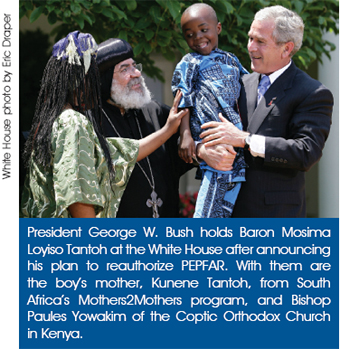 |
“The money that you have spent is being spent wisely and saving lives. Some call this a remarkable success. I call it a good start.”
President George W. Bush
World AIDS Day Observance
November 30, 2007
Partnerships Create Hope
Just five years ago, many wondered whether HIV prevention, treatment and care could ever successfully be provided in resource-limited settings where HIV was a death sentence. Only 50,000 people living with HIV in all of sub-Saharan Africa were receiving antiretroviral treatment.
President Bush and a bipartisan Congress reflected the compassion and generosity of the American people as together they led the United States to lead the world in restoring hope. They recognized that HIV/ AIDS was and is a global health emergency requiring emergency action.
Their creation, the U.S. President’s Emergency Plan for AIDS Relief (Emergency Plan/PEPFAR), holds a unique place in the history of public health for its size and scope:
In size, with a final funding level of $18.8 billion across five years, it is the largest international |
|
health initiative in history dedicated to a single disease. PEPFAR also went beyond a commitment to allocating resources to a commitment to achieving results, with ambitious goals to support prevention of 7 million new infections, treatment of 2 million and care for 10 million.
In scope, it is the first large-scale effort to tackle a chronic disease in the developing world. It moves beyond isolated efforts and pendulum swings that led programs to focus on HIV prevention or treatment or care to sound public health — integrated prevention, treatment and care.
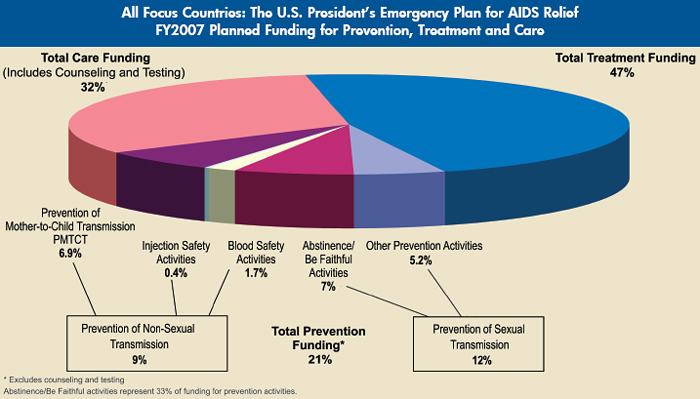
|
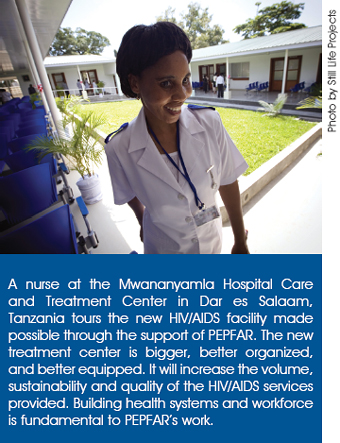 |
The success of the Emergency Plan is firmly rooted in partnerships between the American people and the people of the countries in which we are privileged to serve — governments, non-governmental organizations including faith- and community-based organizations, and the private sector. Together, we are building systems and empowering individuals, communities and nations to tackle HIV/AIDS. And in just four years, it is working.
PEPFAR is working around the world, with a special emphasis on 15 focus countries that together account for approximately half of the world’s HIV infections. PEPFAR has acted quickly, obligating 94 percent of the funds appropriated so far, and expending or outlaying 59 percent of them. But success in not measured in dollars spent: it is measured in services provided and lives saved. PEPFAR is on its way to achieve its aggressive goals.
- In fiscal year (FY) 2007, PEPFAR partnered with 2,217 local organizations — up from 1,588 in 2004 — and 87 percent of partners were local.
- PEPFAR estimates its investment in network development, human resources and local organization capacity development in FY 2007 at roughly $640 million.
- From FY2004 through FY2007, PEPFAR supported nearly 2.6 million training and retraining encounters for health care workers. In FYs 2006 and 2007, PEPFAR provided approximately $281 million to support training activities.
|
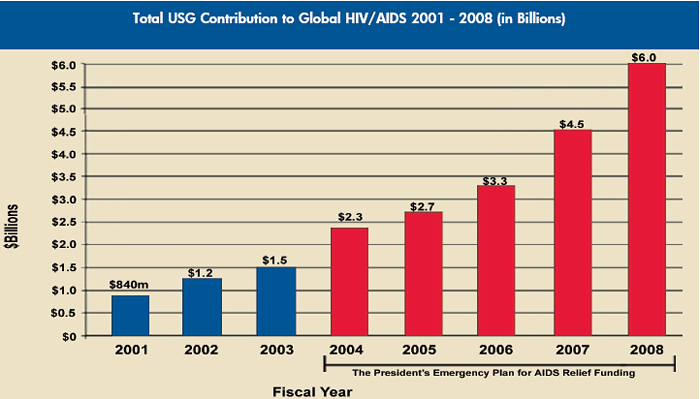
|
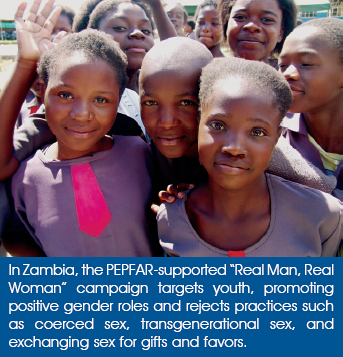 |
Partnerships for Prevention
Treatment and care alone cannot defeat the pandemic. The best approach to treatment, care and all the other challenges posed by HIV/AIDS is to prevent infection in the first place. Without effective prevention, the growing number of people in need of treatment and care will overwhelm the world’s ability to respond.
Recognizing this, the Emergency Plan supports the most comprehensive, evidence-based prevention program in the world, focusing on sexual transmission with the ABC strategy (Abstain, Be Faithful, correct and consistent use of Condoms), mother-to-child transmission, the transmission of HIV through unsafe blood and medical injections, and male circumcision. Prevention interventions are targeted based on the epidemiology of HIV infections in each country.
An example of PEPFAR’s evolving prevention approach in 2007 is the increase in funding for male circumcision, following studies in 2006 that showed this procedure could significantly reduce the risk of HIV transmission for men. Discordant couples – in which one partner is living with HIV and the other is not – are another important focus for intensive HIV prevention interventions.
|
|
Prevention Summary
PEPFAR Five-Year Goal:
- Support prevention of 7 million new infections
Progress Achieved through September 30, 2007:
- Reached approximately 57.6 million people through community outreach programs to prevent sexual transmission in the focus countries during FY2007
- U.S. Government has supplied nearly 1.9 billion condoms worldwide from 2004 through 2007
- Since PEPFAR’s inception, supported prevention of mother-to-child transmission for women during more than 10 million pregnancies
- For pregnant women found to be HIV-positive, provided antiretroviral prophylaxis in more than 827,000 pregnancies, preventing an estimated 157,000 infant HIV infections
- Supported the scale-up of safe blood programs in the 15 focus countries, 11 of which can now meet more than half of their annual demand for safe blood — up from just four when PEPFAR started
Allocation of Resources in FY2007:
- In the focus countries in FY2007, PEPFAR provided $601 million to support prevention activities. This investment represented 21 percent of program funding in the focus countries; if counseling and testing are counted as prevention, this share increases to 29 percent.
| |
|
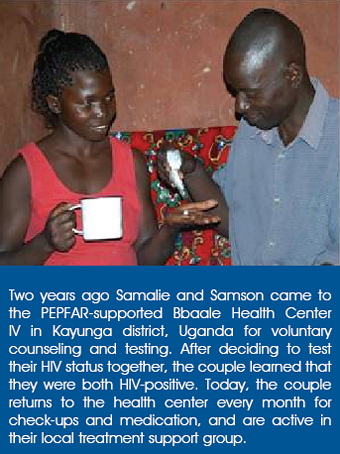 |
“...America is leading the fight against disease. … Our Emergency Plan for AIDS Relief is treating 1.4 million people. We can bring healing and hope to many more.”
President George W. Bush
2008 State of the Union Address
January 28, 2008
Partnerships for Treatment
For the first time, the number of people dying from AIDS has declined. UNAIDS estimates that deaths from AIDS-related causes fell from 2.2 million in 2005 to 2.1 million in 2007 – a small decrease that represents a hopeful trend. This change is due largely to the increased availability of antiretroviral treatment.
Because of the commitment of resources and talented people in-country, many countries have achieved massive improvements in their national levels of antiretroviral treatment coverage.
Lives prolonged through treatment do not affect only those on treatment, but also those for whom they are parents, teachers, or caregivers. The importance of treatment is not simply the number of people receiving treatment, but the daily impact on individual lives – and therefore on families, communities, and nations.
|
|
Treatment Summary
PEPFAR Five-Year Goal:
- Support treatment for 2 million HIV-infected individuals
Progress Achieved through September 30, 2007:
- Supported antiretroviral treatment for approximately 1.45 million men, women, and children through September 2007 — including approximately 1.36 million in the 15 PEPFAR focus countries, and more than 1.33 million in sub-Saharan Africa
- Treatment support is estimated to save nearly 3.2 million adult years of life through September 2009
Allocation of Resources in FY2007:
- In FY2007, PEPFAR provided $1.34 billion in support of treatment programs, including treatment for pediatric patients, or 48 percent of program funding in the focus countries.
| |
|
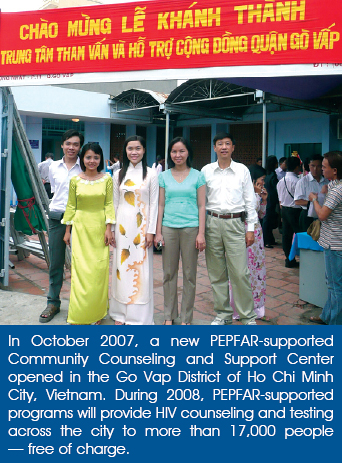 |
Partnerships for Care
As the pendulum of debate in HIV/AIDS interventions swings between prevention and treatment, it is often care that is lost. Yet care is a critical element of a truly comprehensive approach.
There are three key dimensions to care: care for orphans and vulnerable children, care (other than antiretroviral treatment) for people living with HIV/AIDS, and HIV counseling and testing. All are essential to a comprehensive global response to HIV/AIDS. Despite significant progress by PEPFAR in all three areas, more needs to be done.
Care programs also provide a platform for a range of services to allow people living with HIV/AIDS to stay healthy and delay the need for treatment. These care services can include pain and symptom management; treatment and prevention of opportunistic infections and other diseases; social, spiritual, and emotional support; and compassionate end-of-life care.
Children are often deeply affected by their HIV-infected parents and community members through loss of care, income, nutritional food, and schooling. For those who are orphaned or made vulnerable, care activities emphasize strengthening communities to meet the needs of orphans and vulnerable children, supporting community-based responses, helping children and adolescents meet their own needs, and creating a supportive social environment to ensure a sustainable response. PEPFAR recognizes the urgency of addressing these growing needs.
Knowing one’s status provides a gateway for critical prevention, treatment, and care. PEPFAR programs work to ensure that counseling and testing is targeted to those at increased risk of HIV infection.
|
|
Care Summary
PEPFAR Five-Year Goal:
- Support care for 10 million infected and affected by HIV/AIDS, including orphans and vulnerable children
Progress Achieved through September 30, 2007:
- Supported care for more than 6.6 million people infected or affected by HIV/AIDS, including 2.7 million orphans and vulnerable children
- Supported counseling and testing for more than 33 million people to date, including more than 10 million pregnant woman at antenatal clinics
Allocation of Resources in FY2007:
- In FY2007, PEPFAR provided $906.5 million, or 31 percent of focus country program resources, in support of care (including $223 million for counseling and testing programs).
| |
|
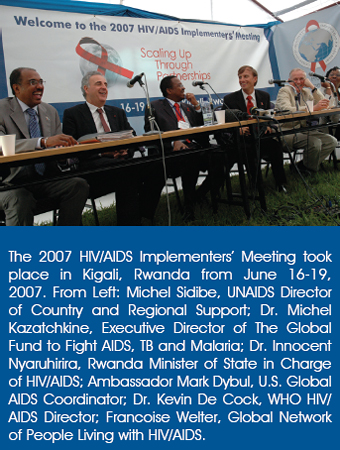
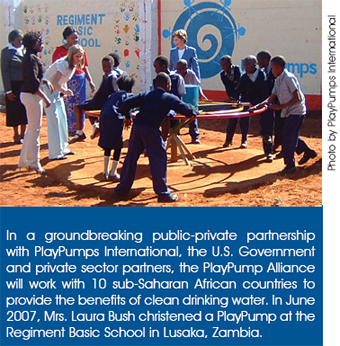 |
“The Emergency Plan includes specific, measurable targets for progress. It puts local partners in the lead, because they know the needs of their people best.”
President George W. Bush
World AIDS Day Observance
November 30, 2007
PEPFAR: Part of a New Era of Development
PEPFAR represents a bold change from traditional thinking about HIV/AIDS and development, and is part of a new era of partnerships for international development.
This new era – with a particular focus on Africa – represents both a massive commitment of treasure and a change of heart. The United States is changing the paradigm for development, rejecting the flawed “donor-recipient” mentality and replacing it with an ethic of partnership.
The Emergency Plan is central to U.S. efforts to “connect the dots” of international development. PEPFAR programs are increasingly linked to other important programs – including those of other USG agencies and other international partners – that meet the needs of people infected or affected by HIV/AIDS in such areas as nutrition, education, and gender.
Promoting Sustainability and Accountability
With support from PEPFAR, host countries are developing and expanding a culture of accountability that is rooted in country, community, and individual ownership of and participation in the response to HIV/AIDS.
While HIV/AIDS is unmistakably the focus of PEPFAR, the initiative’s support for technical and organizational capacity-building for local organizations has important spillover effects that support nations’ broader efforts for sustainable development. |
Back to Report Main Page
|
| |  |  |



